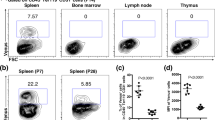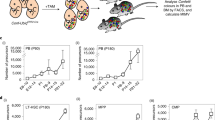Abstract
The source of stem cells within the early mammalian embryo has not been identified. The yolk sac, once thought to provide the early stem cells in birds, is now seen more as a primitive effector organ capable of allorecognition, natural cytotoxic reactions and elaboration of cytokines1–4. In lower vertebrates the source appears to be within a region delineated by the anterior limbs, foregut and mesonephros5–9. That region defines the boundaries of the developing omentum, a fold in the peritoneum. As the omentum is known to develop lymphoid cells postnatally10,11 we have now examined the omental rudiment for the presence of lymphoid cell precursors. Our experiments provide evidence that the presumptive omentum of the 13-day mouse embryo is capable of histiotypic differentiation into a reticular organ containing a significant number of Thy 1+ lymphocytes, which suggests that the omentum may represent a new primary lymphoid organ in the mouse.
This is a preview of subscription content, access via your institution
Access options
Subscribe to this journal
Receive 51 print issues and online access
$199.00 per year
only $3.90 per issue
Buy this article
- Purchase on Springer Link
- Instant access to full article PDF
Prices may be subject to local taxes which are calculated during checkout
Similar content being viewed by others
References
Auerbach, R., Cairns, J. S. & Roehm, N. A. Fortschr. Zool. 26, 287–305 (1981).
Dahl, C. A., Kahan, B. W. & Auerbach, R. in Development and Differentiation of Vertebrate Lymphocytes (ed. Horton, J. D.) 241–253 (Elsevier, Amsterdam, 1980).
Dahl, C. A. J. Immun. 125, 1924–1927 (1980).
Auerbach, R., Globerson, A. & Umiel, T. The Reticuloendothelial System Vol. 3 (ed. Cohen, N.) (Plenum, New York, in the press).
Turpen, R. Development and Differentiation of Vertebrate Lymphocytes (ed. Horton, J. D.) 15–24 (Elsevier, Amsterdam, 1980).
Tompkins, R., Volpe, E. P. & Reinschmidt, D. C. Development and Differentiation of Vertebrate Lymphocytes (ed. Horton, J. D.) 25–34 (Elsevier, Amsterdam, 1980).
Lassila, O., Eskola, J. & Toivanen, P. J. Immun. 123, 2091–2095 (1979).
Lassila, O. Dev. comp. Immun. 5, 403–414 (1981).
Dierterlen-Lievre, F. & Martin, C. Devl Biol. 88, 180–191 (1981).
Trebichavsky, I., Holub, M., Jaroskova, L., Mandel, L. & Kovaru, F. Cell Tissue Res. 215, 437–442 (1981).
Dux, K., Przenmyslaw, J. & Szaniawska, B. Cell. Immun. 32, 97–109 (1977).
Auerbach, R. Proc. natn. Acad. Sci. U.S.A. 47, 1175–1181 (1961).
Auerbach, R. J. natn. Cancer Inst. Monogr. 11, 23–33 (1962).
Van Ewijk, W., Jenkinson, E. J. & Owen, J. J. T. Eur. J. Immun. 12, 262–271 (1982).
Owen, J. J. T. Prog. Allergy 29, 1–34 (1981).
Schrader, J. W., Battye, F. & Scollay, R. Proc. natn. Acad. Sci. U.S.A. 79, 4161–4165 (1982).
Mathieson, B. J., Sharrow, S. O., Rosenberg, Y. & Hammerling, U. Nature 289, 179–181 (1981).
Manohar, V., Brown, E., Leiserson, W. M. & Chused, T. M. J. Immun. 129, 532–538 (1982).
Author information
Authors and Affiliations
Rights and permissions
About this article
Cite this article
Kubai, L., Auerbach, R. A new source of embryonic lymphocytes in the mouse. Nature 301, 154–156 (1983). https://doi.org/10.1038/301154a0
Received:
Accepted:
Issue Date:
DOI: https://doi.org/10.1038/301154a0
Comments
By submitting a comment you agree to abide by our Terms and Community Guidelines. If you find something abusive or that does not comply with our terms or guidelines please flag it as inappropriate.



